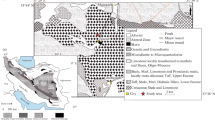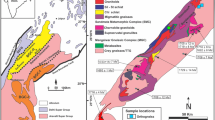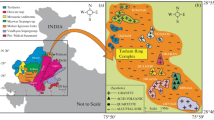Abstract
The present study is carried out to probe geodynamic evolution and tectonic history of A-type granitoids from the Riwasa and Nigana areas in the Tusham Ring Complex (TRC), western Peninsular India on the basis of petrological and geochemical aspects. The investigated rocks have the characteristics of hypersolvus, calc-alkaline, peraluminous and A-type granitoids. They are enriched in SiO2, Na2O+K2O, Fe/Mg, Th, U, REE (except Eu), LILE+HFSE, elevated in Fe/Mg, Ga/Al, Th/U, A/CNK ratios, and depleted in CaO, MgO, Sr, Cr, Ni, P, and Ti, and having Eu abundances. They also show high heat production (HHP) affinity and high mineralization potential. Elemental geochemistry in conjunction with mineralogical variants attested that they were formed by limited fractional crystallization of a parental magma derived from partial melting of crustal protolith accreted during the Neoproterozoic magmatic event. Physicochemical features i.e. F and Cl-rich biotite, pegmatite rim, substantial model content of albite, high mineralized veins and altered mineralogy indicate rock-fluid interactions which are caused by magmatic origin or secondary metasomatic alteration superimposed on the host rock. The magmatism occurred in the TRC is interpreted to represent the Malani Igneous Suite (MIS) and their linkage with Rodinia Supercontinent and Pan-African thermal event.




















Similar content being viewed by others
REFERENCES
A. Agangi, V. S. Kamenetsky, and J. McPhie, “The role of fluorine in the concentration and transport of lithophile trace elements in felsic magmas: Insights from the Gawler Range Volcanics, South Australia,” Chem. Geol. 273, 314‒325 (2010).
J. L. Anderson, “Mineral equilibria and crystallization conditions in the late Precambrian Wolf River Rapakivi Massif, Wisconsin,” Am. J. Sci. 280, 289‒332 (1980).
L. D. Ashwal, A. M. Solanki, M. K. Pandit, F. Corfu, B. W. H. Hendriks, K. Burke, and T. H. Torsvik, “Geochronology and geochemistry of Neoproterozoic Mt. Abu granitoids, NW India: Regional correlation and implications for Rodinia paleogeography,” Precambrian Res. 236, 265‒281 (2013).
L. E. Le Bas, M. J. Maitre, R. W. Streckeisen, and A. B. Zanettin, “A chemical classification of volcanic rocks based on the total alkali-silica diagram,” J. Petrol. 27, 747‒750 (1986).
R. A. Batchelor and P. Bowden, “Petrogenetic interpretation of granitoid rock series using multicationic parameters,” Chem. Geol. 48, 43‒55 (1985).
F. Bea, “Residence of REE, Y, Th and U in granites and crustal protoliths implications for the chemistry of crustal melts,” J. Petrol. 37, 521‒552 (1996).
M. Z. El-Bialy, “On the Pan-African transition of the Arabian-Nubian Shield from compression to extension: The post-collision Dokhan volcanic suite of Kid-Malhak region, Sinai, Egypt,” Gondwana Res. 17, 26‒43 (2010).
M. Biste, “Application of various geochemical proximity indicators to the tin favourability of South Sardinian granites,” J. Geochem. Explor. 15, 295‒306 (1981).
B. Bonin, “Peralkaline granites in Corsica: Some petrological and geochemical constraints,” Rend. Soc. Ital. Mineral. Petrol. 43 (2), 281‒306 (1988).
B. Bonin, “A-type granites and related rocks: Evolution of a concept, problems and prospects,” Lithos 97, 1‒29 (2007).
D. B. Clarke, M. A. McDonald, and S. Erdmann, “Chemical variation in Al2O3–CaO–Na2O–K2O space: Controls on the peraluminosity of the South Mountain Batholith,” Can. J. Earth. Sci. 41, 785‒798 (2004).
J. D. Clemens, J. R. Holloway, and A. J. R. White, “Origin of an A-type granite: Experimental constraints,” Am. Mineral. 71, 317– 324 (1986).
A. R. Crawford and W. Compston, “The age of the Vindhyan system of peninsular India,” Q. J. Geol. Soc. London 125, 351‒370 (1970).
S. Dhar, R. Frel, S. J. D. Kramer, T. F. Nagler, and N. Kochhar, “Sr, Pb and Nd isotope studies and their bearing on the petrogenesis of the Jalor and Siwana complexes, Rajasthan, India,” J. Geol. Soc. India 48, 151‒160 (1996).
G. N. Eby and N. Kochhar, “Geochemistry and petrogenesis of the Malani Igneous Suite, North Peninsular India,” J. Geol. Soc. India 36, 109‒130 (1990).
G. N. Eby, “Chemical subdivision of the A-type granitoids: Petrogenetic and tectonic implications,” J. Geol. India 20, 641‒644 (1992).
B. R. Frost and C. D. Frost, “A geochemical classification for feldspathic igneous rocks,” J. Petrol. 49, 1955‒1969 (2008).
C. D. Frost and B. R. Frost, “On ferroan (A-type) granitoids: Their compositional variability and modes of origin,” J. Petrol. 52, 39‒53 (2011).
A. V. Grebennikov, “A-type granites and related rocks: Petrogenesis and classification,” Russ. Geol. Geophys. 55, 1074‒1086 (2014).
L. C. Gregory, J. G. Meert, B. Bingen, M. K. Pandit, and T. H. Torsvik, “Paleomagnetism and geochronology of the Malani Igneous Suite, Northwest India: Implications for the configuration of Rodinia and the assembly of Gondwana,” Precambrian Res. 170, 13‒26 (2009).
R. K. Gupta, “Embayed quartz crystals in Shyok volcanics, Ladakh,” Contemp. Geosci. Res. Himalaya 2, 65–68 (1983).
A. N. Halliday, “Recent developments in dating ancient crustal fluid flow,” Rev. Geophys. 29, 577‒584 (1991).
P. Hollings, P. Fralick, and S. Kissin, “Geochemistry and geodynamic implications of the Mesoproterozoic English Bay granite-rhyolite complex, Northwestern Ontario,” Can. J. Earth Sci. 41, 1329‒1338 (2004).
D. Huang, X. L. Wang, X. P. Xia, Y. S. Wan, F. F. Zhang, J. Y. Li, and D. H. Du, “Neoproterozoic low-δ18O zircons revisited: Implications for Rodinia configuration,” Geophys. Res. Lett. 46, 678–688 (2019).
D. N. Juniper and J. D. Kleeman, “Geochemical characterization of some tin-mineralizing granites of New South Wales,” J. Geochem. Explor. 11, 321‒333 (1979).
P. Kaur, N. Chaudhri, and N. Eliyas, “Chlorine-rich amphibole and biotite in the A-type granites, Rajasthan, NW India: Potential indicators of subsolidus fluid-rock interaction and metallogeny,” Geol. J. 54, 614‒630 (2019).
P. Kepezhinkas, F. McDermott, M. J. Defant, A. Hochstacdter, M. S. Drummond, C. J. Hawkeswaorth, A. Koloskov, R. C. Maury, and H. Bellon, “Trace element and Sr‒Nd‒Pb isotopic constraints on a three component model on Kamchatka arc petrogenesis,” Geochim. Cosmochim. Acta 61, 577‒600 (1997).
P. L. King, A. J. R. White, B. W. Chappel, and C. M. Allen, “Characterization and origin of aluminous A-type granites from the Lachlan Fold Belt, Southeastern Australia,” J. Petrol. 38, 371‒391 (1997).
J. A. Kinnaird, “Hydrothermal alteration and mineralization of the alkaline anorogenic ring complex of Nigeria,” J. Afr. Earth Sci. 3, 229‒251 (1985).
N. Kochhar, “Tusham ring complex, Bhiwani district, India,” Proc. Indian Natl. Sci. Acad. 49, 459‒490 (1984).
N. Kochhar, “A type Malani magmatism: Signatures of the Pan-African event in the Northwest Indian shield assembly of the Late Proterozoic Malani Supercontinent,” Geol. Surv. India, Spec. Publ. 91, 112‒126 (2008).
N. Kochhar, “The Malani Supercontinent,” Front. Earth Sci. 45, 120‒135 (2015).
D. Konopelko, G. Biske, R. Seltmann, O. Eklund, and B. Belyatsky, “Hercynian post-collisional A-type granites of the Kokshaal Range, Southern Tien Shan, Kyrgyzstan,” Lithos 97, 140–160 (2007).
N. Kumar, N. Kumar, and A. K. Singh, “Petrology and geochemistry of acid volcano-plutonic rocks from Riwasa and Nigana areas of Neoproterozoic Malani Igneous Suite, Northwestern Peninsular India: An understanding approach to magmatic evolution,” Geochem. Int. 57, 645‒667 (2019).
S. Kumar, T. Pieru, V. Rino, and Y. Hayasaka, “Geochemistry and U–Pb SHRIMP zircon geochronology of microgranular enclaves and host granitoids from the South Khasi Hills of the Meghalaya Plateau, NE India: Evidence of synchronous mafic–felsic magma mixing–fractionation and diffusion in a post-collision tectonic environment during the Pan-African orogenic cycle,” in Crustal Evolution of India and Antarctica: The Supercontinent Connection, Vol. 457 of Geol. Soc. London, Spec. Publ., Ed. by N. S. Pant and S. Dasgupta (London, 2017), pp. 1‒16.
N. Kumar and G. Vallinayagam, “Tectonic significance of the Neoproterozoic magmatism of Nakora area, Malani Igneous Suite, District Barmer, Western Rajasthan, India,” Geotectonics 48, 239‒253 (2014).
Z. X. Li, S. V. Bogdanova, A. S. Collins, A. Davidson, B. De Waele, R. E. Ernst, I. C. W. Fitzsimons, R. A. Fuck, D. P. Gladkochub, J. Jacobs, K. E. Karlstrom, S. Lu, L. M. Natapov, V. Pease, S. A. Pisarevsky, et al., “Assembly, configuration, and break-up history of Rodinia: A synthesis,” Precambrian Res. 160, 179‒210 (2008).
Z. Liu, S. C. Tan, X. H. He, D. B. Wang, and B. Gao, “Petrogenesis of mid-Neoproterozoic (ca. 750 Ma) mafic and felsic intrusions in the Ailao Shan–Red River belt: Geochemical constraints on the paleogeographic position of the South China block,” Geol. Soc. Am. Bull. 11, 348‒364 (2019).
A. Lindh, M. A. Abu-El-Rus, M. A. M. Mohamed, P. O. Persson, and A. Schersten, “A model for granite evolution based on non-equilibrium magma separation: Evidence from the Gharib and Qattar fluorite-bearing granites, Eastern Desert, Egypt,” Int. J. Earth. Sci. 108, 1201‒1232 (2019).
M. Lopez-Plaza, M. Peinado, F. J. Lopez Moro, M. D. R. Alonso, A. Carnicero, M. P. Franco, J. C. Gonzalo, and M. Navidad, “Contrasting mantle sources and processes involved in a peri-Gondwanan terrane: A case study of pre-Variscan mafic intrusives from the autochthon of the Central Iberian Zone,” in The Evolution of the Rheic Ocean: From Avalonian-Cadomian Active Margin to Alleghenian-Variscan Collision, Vol. 423 of Geol. Soc. Am., Spec. Pap., Ed. by U. Linnemann, R. D. Nance, P. Kraft, and G. Zulauf (2007), pp. 297–313.
A. Maheshwari, M. Coltorti, S. K. Rajput, and M. Verma, “Geochemical characteristics, discrimination and petrogenesis of Neoproterozoic peralkaline granites, Barmer district, SW Rajasthan, India,” Int. Geol. Rev. 15, 1103‒1120 (2009).
P. D. Maniar and P. M. Piccoli, “Tectonic discrimination of granitoids,” Geol. Soc. Am. Bull. 101, 635‒643 (1989).
J. F. Menuge, T. S. Brewer, and C. M. Seeger, “Petrogenesis of metaluminous A-type rhyolite from the St. Francois Mountains, Missouri and Mesoproterozoic evolution of the Southern Laurentian margin,” Precambrian Res. 113, 269‒291 (2002).
E. A. K. Middlemost, Magmas and Magmatic Rocks: An Introduction to Igneous Petrology (Longman, London, 1985).
A.-K. M. Moghazi, L. M. Laccheri, R. A. Bakhsh, A. B. Kotov, and K. A. Ali, “Sources of rare-metal-bearing A-type granites from Jabel Sayed Complex, Northern Arabian Shield, Saudi Arabia,” J. Asian Earth. Sci. 107, 244‒258 (2015).
A. F. Osman and B. A. El Kalioubi, “Neoproterozoic post-collisional granitoids in the central eastern desert of Egypt: Petrological and geochemical constraints,” J. Afr. Earth Sci. 99, 39‒50 (2014).
M. K. Pandit, L. D. Ashwal, R. D. Tucker, L. M. Carter, B. Van Lante, T. H. Torsvic, B. Jamtveit, and S. K. Bhushan, “Proterozoic acid magmatism in the Northwestern Indian shield and its significance for Rodinia construction,” Gondwana Res. 4, 726‒728 (2001).
W. S. Pitcher, “Intraplate, rift-related magmatism: Mainly the A-type, alkali feldspar granites,” in The Nature and Origin of Granites (Chapman & Hall, London, 1997), ch. 15, pp. 258‒279.
H. M. Rajesh, “Characterization and origin of a compositionally zoned aluminous A-type granite from South India,” Geol. Mag. 137, 291– 318 (2000).
R. L. Rudnick and S. Gao, “Composition of the continental crust,” in The Crust, Vol. 3 of Treatise on Geochemistry, Ed. by R. L. Rudnick and S. Gao (Springer, Berlin, 2003), pp. 1‒64.
M. Sami, T. Ntaflos, E. S. Farahat, H. A. Mohamed, C. Hauzenberger, and A. F. Ahmed, “Petrogenesis and geodynamic implications of Ediacaran highly fractionated A-type granitoids in the north Arabian-Nubian Shield (Egypt): Constraints from whole-rock geochemistry and Sr‒Nd isotopes,” Lithos 304–307, 329‒346 (2018).
A. K. Singh, R. K. B. Singh, and G. Vallinayagam, “Anorogenic acid volcanic rocks in the Kundal area of the Malani Igneous Suite, Northwestern India: Geochemical and petrogenetic studies,” J. Asian Earth. Sci. 27, 544‒557 (2006).
A. K. Singh and G. Vallinayagam, “Radioactive element distribution and rare-metal mineralization in anorogenic acid volcano-plutonic rocks of the Neoproterozoic Malani Felsic Province, Western Peninsular India,” J. Geol. Soc. India 73, 837‒853 (2009).
L. G. Singh and G. Vallinayagam, “Petrological and geochemical constraints in the origin and associated mineralization of A-type granite suite of the Dhiran area, Northwestern Peninsular India,” Geosciences 2 (4), 66‒80 (2012).
L. S. Singh and G. Vallinayagam, “Geochemistry and petrogenesis of acid volcano-plutonic rocks of the Siner area, Siwana Ring Complex, Northwestern Peninsular India,” J. Geol. Soc. India 82 (1), 67‒79 (2013).
R. Sharma, PhD Thesis (Chandigarh, India, 1992).
R. Sharma and N. Kumar, “Petrology and geochemistry of A-type granites from Khanak and Devsar areas of Bhiwani district, Southwestern Haryana,” J. Geol. Soc. India 90, 138‒146 (2017).
A. L. Streckeisen, “Plutonic rocks: Classification and nomenclature recommended by the IUGS subcommisifron on the systematics of igneous rocks,” Geotimes 18 (10), 26‒30 (1973).
S. S. Sun and W. F. McDonough, “Chemical and isotopic systematics of oceanic basalts: Implications for mantle composition and processes,” in Magmatism in the Ocean Basin, Vol. 42 of Geol. Soc. London, Spec. Publ., Ed. by M. J. Norry and A. D. Saunders (London, 1989), pp. 313–345.
P. J. Sylvester, “Post-collisional alkaline granites,” J. Geol. 97, 261‒280 (1989).
S. R. Taylor and S. M. McLennan, The Continental Crust: Its Composition and Evolution (Blackwell, Oxford, 1985).
T. H. Torsvik, L. M. Carter, L. D. Ashwal, S. K. Bhushan, M. K. Pandit, and B. Jantveit, “Rodinia refined or obscured: Palaeomagnetism of the Malani igneous suite (NW India),” Precambrian Res. 108, 319–333 (2001).
G. Vallinayagam, PhD Thesis (Chandigarh, India, 1988).
G. Vallinayagam and N. Kochhar, “Geochemical characterization and petrogenesis of A-type, granites and the associated acid volcanics of the Siwana Ring Complex, Northern Peninsular, India,” in The Indian Precambrian, Ed. by B. S. Paliwal (Sci. Publ., Jodhpur, India, 1998), pp. 460‒481.
G. Vallinayagam, “Basic magmatism of Neoproterozoic Malani Igneous Suite, Western Indian Craton: Petrological and geochemical modelling,” Indian J. Geochem. 18, 1‒18 (2003).
G. Vallinayagam, “A report on rare metals and rare earths in the Siwana Ring Complex, Rajasthan,” J. Appl. Geochem. 6, 387‒391 (2004).
G. Vallinayagam, “Geochemistry of rare metal and rare earth ore deposits: A study of the Malani Igneous Suite Trans-Aravalli Block of NW peninsular India,” Indian J. Geochem. 21, 439‒446 (2006).
G. Vallinayagam and N. Kochhar, “Petrological evolution and emplacement of Siwana and Jalor ring complexes of Malani Igneous suite, NW peninsular India,” in Topics in Igneous Petrology, Ed. by J. Ray, G. Sen, and B. Ghosh (Springer-Verlag, New York, 2011), ch. 17, pp. 437‒448.
J. B. Whalen, K. L. Currie, and B. W. Chappell, “A‑type granites: Geochemical characteristics, discrimination and petrogenesis,” Contrib. Mineral. Petrol. 96, 407‒419 (1987).
W. Wang, P. A. Cawood, M. F. Zhou, M. K. Pandit, X. Xiao-Ping, and J. H. Zhao, “Low-δ18O rhyolites from the Malani Igneous Suite: A positive test for South China and NW India linkage in Rodinia,” J. Geophys. Res.: Solid Earth 44, 298‒305 (2017).
J. Webster, R. Thomas, H. J. Forster, R. Seltmann, and C. Tappen, “Geochemical evolution of halogen-enriched granite magmas and mineralizing fluids of the Zinnwald tin–tungsten mining district, Erzgebirge, Germany,” Miner. Deposita 39, 452‒472 (2004).
ACKNOWLEDGMENTS
The authors wish to express their thanks to Chairman, Dr. A.R. Chaudhri (Department of Geology, Kurukshetra University, Kurukshetra, India) and Director, Dr. Kalachand Sain (Wadia Institute of Himalayan Geology, Dehradun, India) for their support. We are thankful to N.V. Chalapathi Rao (Banaras Hindu University, Varanasi, India) and Dinesh Pandit (Banaras Hindu University, Varanasi, India) for their assistance to carry out the EPMA analysis. We are also thankful to the anonymous reviewers for their comments which greatly helped in improvement of the manuscript, and also to the editor for efficient editorial handling.
Funding
The first author wishes to acknowledge the financial support of the Junior Research Fellowship, University Grand Commission (UGC) (New Delhi, India) to carry out the research work.
Author information
Authors and Affiliations
Corresponding author
Rights and permissions
About this article
Cite this article
Naveen Kumar, Kumar, N., Sharma, R. et al. Petrogenesis and Tectonic Significance of the Neoproterozoic Magmatism of the Tusham Ring Complex (NW Indian Shield): Insight into Tectonic Evolution of the Malani Igneous Suite and Rodinia Supercontinent. Geotecton. 54, 428–453 (2020). https://doi.org/10.1134/S001685212003005X
Received:
Revised:
Accepted:
Published:
Issue Date:
DOI: https://doi.org/10.1134/S001685212003005X




